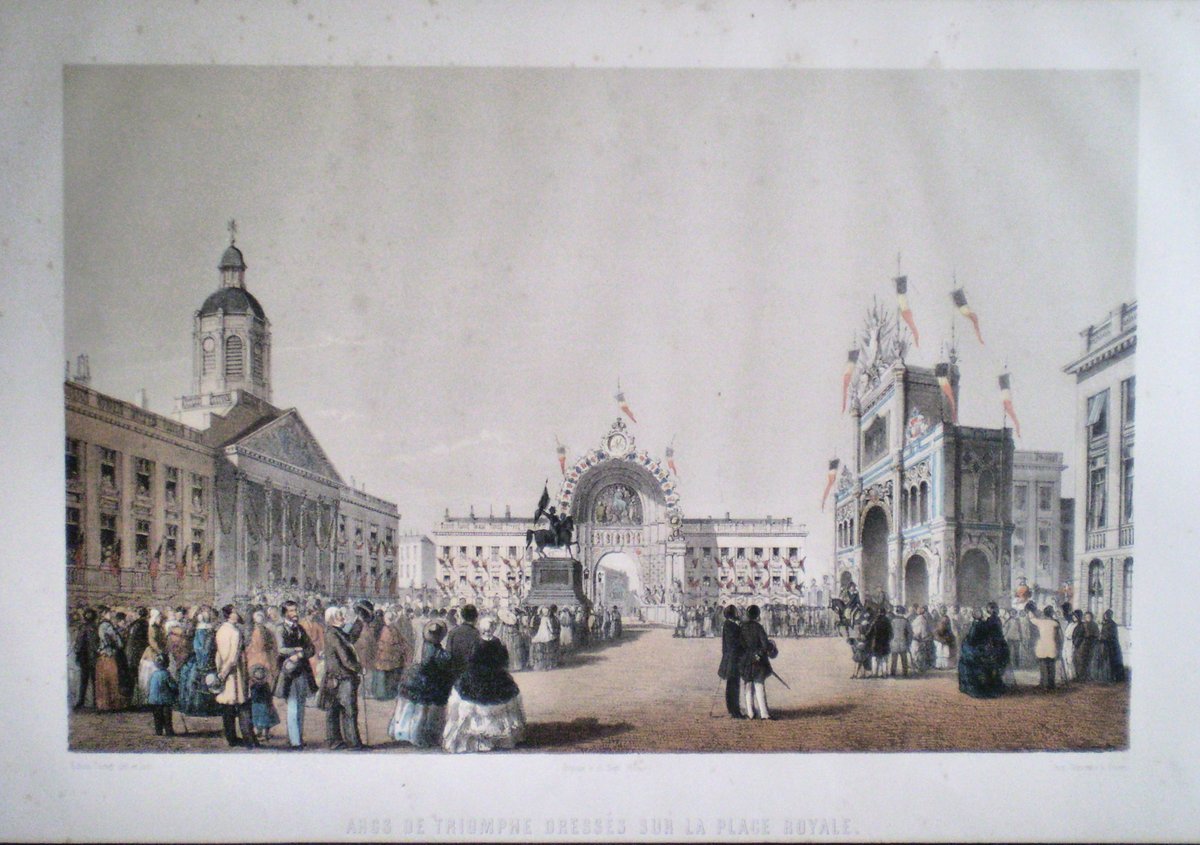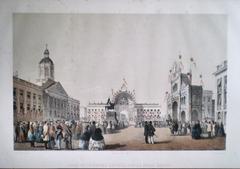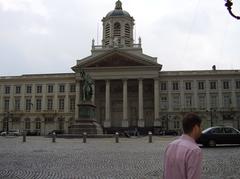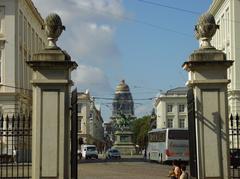
Place Royale Visiting Hours, Tickets, and Historical Sites in Brussels
Date: 14/06/2025
Introduction
Nestled in the heart of Brussels, Place Royale (Koningsplein) stands as one of Belgium’s most emblematic historical and architectural landmarks. Constructed between 1775 and 1782 atop the ruins of the former Coudenberg Palace, this neoclassical square reflects the city’s evolution—from medieval origins and Habsburg rule to its status as the capital of modern Belgium. The harmonious Louis XVI façades, protected as heritage, embody Enlightenment ideals of order and grandeur, while the central equestrian statue of Godfrey of Bouillon symbolizes Belgium’s layered historical identity.
Surrounded by world-class institutions like the Royal Museums of Fine Arts, the Magritte Museum, and the BELvue Museum, Place Royale offers visitors a deep dive into Belgian art, history, and national heritage. This comprehensive guide covers historical significance, practical visitor information (hours, ticketing, accessibility), nearby attractions, transportation, travel tips, and how to stay updated on events—helping history buffs, art lovers, and travelers alike plan a rewarding visit. (Wikipedia; Holidify; Cambridge University Press; Official Royal Museums)
Table of Contents
- Historical Background
- Main Monuments and Cultural Institutions
- Visiting Place Royale: Hours, Tickets, and Accessibility
- Getting There and Transport Updates
- Travel Tips and Visitor Facilities
- Events, Photography, and Etiquette
- Frequently Asked Questions (FAQ)
- Nearby Attractions and Extended Visits
- Conclusion and Resources
1. Historical Background
Origins and Urban Transformation
The Place Royale occupies the former site of the Coudenberg Palace, which was destroyed by fire in 1731. After decades of ruin, the Austrian Habsburg rulers initiated a grand urban renewal in the mid-18th century, inspired by the French neoclassical squares of the Ancien Régime. Construction began in 1775 under architects Jean-Benoît-Vincent Barré and Gilles-Barnabé Guimard, completing in 1782. The square’s design and proportions were intended as a symbol of Habsburg authority and the Enlightenment’s aesthetic ideals. (Wikipedia; Cambridge University Press)
Neoclassical Design and Layout
The square features a strict rectangular layout (approx. 77 by 113 meters), fully paved with regional blue stone. The uniform Louis XVI façades, adorned with Corinthian columns and pediments, are subject to architectural servitude—ensuring their preservation and visual harmony since the 18th century. The southern colonnade was removed in 1827 for urban expansion, but the ensemble remains remarkably intact. (Wikipedia; Holidify)
Political and Social Evolution
Throughout the 19th and 20th centuries, Place Royale mirrored Belgium’s shifting regimes—from the French occupation and Dutch monarchy to Belgian independence in 1830. The square has hosted major events such as the inauguration of Leopold I and Belgian National Day celebrations, reinforcing its status as a civic and ceremonial center. (Cambridge University Press)
2. Main Monuments and Cultural Institutions
Equestrian Statue of Godfrey of Bouillon
At the heart of Place Royale stands the equestrian statue of Godfrey of Bouillon, installed in 1848. Godfrey, a leader of the First Crusade, is celebrated as a national hero and a symbol of Belgian identity. The statue replaced an earlier monument to Charles Alexander of Lorraine, destroyed during the French Revolutionary era. Its placement was a deliberate act of nation-building by the Belgian state. (Wikipedia; Cambridge University Press)
Surrounding Landmarks
- Church of St. James on Coudenberg (Église Saint-Jacques-sur-Coudenberg): Dominates the eastern side of the square, showcasing neoclassical architecture (completed in 1787).
- Royal Museums of Fine Arts of Belgium: Houses extensive collections from Flemish Primitives to contemporary art (Official Royal Museums).
- Magritte Museum: Celebrates the surrealist artist René Magritte (Magritte Museum).
- BELvue Museum: Focuses on Belgian history and identity, also providing access to the archaeological remains of the Coudenberg Palace (BELvue Museum).
Beneath the square, visitors can explore the Aula Magna and vaults of the former Coudenberg Palace, accessible via the BELvue Museum.
3. Visiting Place Royale: Hours, Tickets, and Accessibility
Visiting Hours
- Place Royale Square: Open 24/7, year-round.
- Royal Museums of Fine Arts & Magritte Museum: Tuesday–Sunday, 10:00 AM–5:00 PM; closed Mondays.
- BELvue Museum: Tuesday–Sunday, 10:00 AM–5:00 PM.
- Royal Palace of Brussels: Open for free guided tours in summer (July–August), 10:30 AM–4:30 PM (check for annual updates).
Tickets
- Square: Free public access.
- Royal Museums of Fine Arts: €10–€15 for adults; discounts for students, seniors, and children; combined tickets available (Official Royal Museums).
- BELvue Museum: €8–€10 for adults, with similar discounts.
- Magritte Museum: €10–€15; combined tickets available (Magritte Museum).
- Royal Palace: Free entry during open season (advance booking recommended).
Tickets can be purchased online or at entrances; advance booking is advised during peak periods.
Accessibility
- Square: Mostly step-free, though cobblestones may be uneven.
- Museums: Generally wheelchair-accessible, with ramps, lifts, and accessible restrooms.
- Restrooms: Available in museums and cafés.
- Seating: Limited on the square; more in nearby parks and museum cafés.
4. Getting There and Transport Updates
Public Transport
- Metro: Parc/Park station (lines 1 & 5), 5-minute walk.
- Tram: Lines 92 and 94 (Palais stop); note current disruptions below.
- Bus: Lines 33, 38, 71, 95, and others serve Royale/Koning and nearby stops.
- Train: Brussels Central Station, 10-minute walk.
For route planning and real-time schedules, visit STIB-MIVB.
Transport Updates (June 2025)
- Tram Disruptions: Tram lines 92 and 93 face interruptions due to ongoing works; Palais/Paleizen stop is not served. Use metro lines 2 or 6 as alternatives. (STIB-MIVB)
- Bus Alternatives: Bus lines remain operational around Petit Sablon and Royale.
- Pedestrian Access: The square is being transformed into a partially pedestrian area. Some zones may be fenced off during works.
Parking
- Interparking Square Albertine (Rue des Sols 3, 1000 Brussels)
- Parking Sablon-Poelaert (Place Poelaert 1, 1000 Brussels)
Street parking is limited and regulated.
5. Travel Tips and Visitor Facilities
- Best Time to Visit: Early mornings or late afternoons are quieter. Weekends and holidays are busier, especially during events and summer.
- Weather: Be prepared for variable conditions; bring rain gear.
- Food & Drink: Museum cafés and nearby Sablon brasseries offer Belgian waffles, chocolates, and local cuisine.
- Shopping: The Sablon area features antiques, art galleries, boutiques, and museum gift shops.
- Picnic & Relaxation: Parc de Bruxelles (Royal Park) is adjacent, ideal for breaks.
6. Events, Photography, and Etiquette
- Events: Place Royale hosts National Day celebrations (July 21), public art installations, and open-air concerts. Museums run temporary exhibitions and cultural festivals. (Visit Brussels)
- Photography: Permitted outdoors. Museum policies vary.
- Etiquette: Respect monuments, government and religious sites, and event restrictions. Drone use is prohibited without permits.
7. Frequently Asked Questions (FAQ)
Q: What are the visiting hours for Place Royale?
A: The square is open 24/7. Museums and attractions typically open 10:00 AM–5:00 PM, Tuesday–Sunday.
Q: Are tickets required?
A: No tickets for the square. Museums and palace require tickets or advance booking.
Q: Is the area accessible for people with disabilities?
A: Yes, with step-free access and facilities in most museums. Some cobblestone areas may be uneven.
Q: How do I get there by public transport?
A: Metro, tram, bus, and train options are available with stops within walking distance.
Q: Are guided tours available?
A: Yes, at museums and the Royal Palace in summer. Walking tours are also offered. (Introducing Brussels)
8. Nearby Attractions and Extended Visits
- Mont des Arts: Panoramic views and cultural institutions.
- Grand Place: Brussels’ main square, 10 minutes by foot.
- Petit Sablon: Tranquil garden with historical statues.
- Musical Instruments Museum: 8,000+ instruments in Art Nouveau setting.
- Coudenberg Palace Archaeological Site: Explore the city’s royal ruins.
9. Conclusion and Resources
Place Royale is a captivating blend of neoclassical architecture, historical significance, and vibrant cultural life. Open to the public at all hours, the square is a gateway to Brussels’ royal quarter, with adjacent museums, archaeological sites, and frequent events. Plan ahead—considering museum hours, ticket options, and transport updates—to make the most of your visit. Download the Audiala app for guided tours, stay updated with local resources, and immerse yourself in Brussels’ royal heritage. (Audiala)
References and Further Reading
- Wikipedia
- Holidify
- Cambridge University Press
- Royal Museums of Fine Arts of Belgium
- Magritte Museum
- BELvue Museum
- Visit Brussels
- STIB-MIVB
- Audiala
- Introducing Brussels
- City of Brussels






































































































































